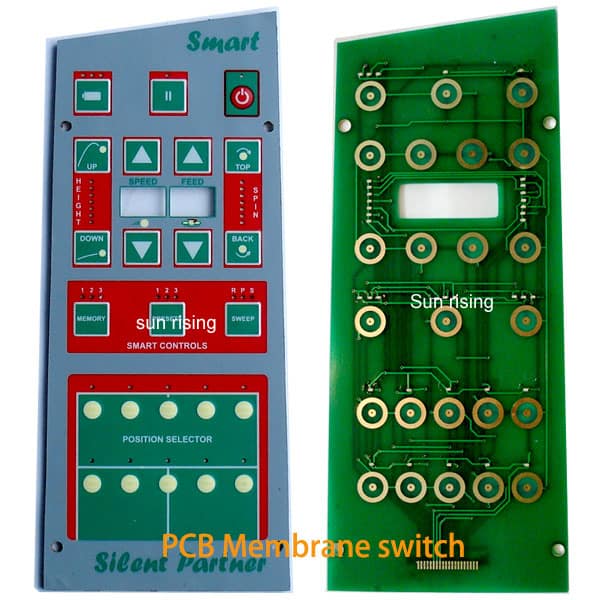The Importance of Membrane Switches in Creating User-Friendly Interfaces
How Membrane Layer Changes Enhance User Experience in Gadget
Membrane layer switches play a crucial duty in improving customer experience across various tools by integrating intuitive design principles and efficient responsive responses devices. Their capability to give clear activation feedbacks not only decreases mistakes yet likewise infuses a sense of self-confidence in users. Additionally, the visual flexibility of these buttons adds to brand identification while ensuring functionality under diverse conditions. As markets significantly look for services that incorporate resilience with user-centric layout, the implications of membrane layer changes warrant more exploration to completely appreciate their effect on contemporary innovation.
Improved Tactile Feedback
Improved responsive comments in membrane layer changes significantly boosts individual experience by providing clear, responsive communications. This comments is essential in applications where precision and user self-confidence are vital, such as medical gadgets and commercial controls. By integrating attributes such as responsive domes or increased aspects, membrane changes enable users to feel a distinct reaction upon activation, thus lowering the chance of unintentional inputs.
The assimilation of tactile comments serves to bridge the gap between the physical and digital worlds, using customers an encouraging verification of their actions. This interaction not only cultivates a sense of control but also lowers the cognitive lots, as customers can depend on their sense of touch to browse via various functions. Enhanced responsive feedback can result in increased effectiveness, as drivers can execute commands quickly without requiring to aesthetically verify each activity.

Moreover, the integrity of responsive comments in membrane switches adds to general product usability. When customers can with ease engage with a gadget, it cultivates a more positive communication, bring about greater fulfillment and commitment. Therefore, the execution of boosted responsive responses is a vital consideration for developers aiming to boost the individual experience within their products.
Enhanced Appearances and Design
Visual charm plays an essential role in the capability and marketability of membrane buttons. These switches supply a seamless assimilation of kind and function, allowing manufacturers to develop visually striking interfaces that boost individual engagement. With personalized layouts, shades, and structures, membrane layer switches can be customized to align with brand identity and item aesthetic appeals, making them an eye-catching selection for various applications.

Moreover, using high-grade materials and printing techniques ensures that the aesthetic components stay vibrant and intact with time, reinforcing the total quality of the gadget. By prioritizing looks in membrane button style, suppliers can considerably enhance the customer experience, fostering a positive psychological link in between the user and the device while promoting brand name loyalty.
Enhanced Sturdiness and Durability
Beyond their aesthetic appeal, membrane layer switches are identified for their enhanced longevity and longevity, making them a functional option for a wide variety of applications. Built from durable site products such as polyester or polycarbonate, these switches can hold up against extreme ecological problems, including direct exposure to moisture, dirt, and chemicals. This durability is critical for tools used in industrial, medical, and exterior settings, where devices is typically based on strenuous usage.
Membrane layer switches are likewise less prone to mechanical failure compared to typical mechanical switches. The lack of relocating components minimizes the likelihood of wear and tear, consequently expanding the functional life-span of the gadget. In addition, their sealed design prevents pollutants from getting in the button, further boosting dependability.

Simplified User Communication
3 key factors add to the simplified individual communication offered by membrane switches: intuitive layout, tactile feedback, and customizable formats. The instinctive style of membrane layer switches over enables users to quickly understand and navigate the user interface without considerable training. This user-centric strategy makes sure that controls are logically prepared, facilitating ease of usage and decreasing the cognitive load on users.

In addition, customizable formats make it possible for producers to customize the user interface to certain applications and individual demands. By allowing for the assimilation of individualized signs, shades, and button plans, membrane layer buttons can be developed to match the requirements of varied user demographics, enhancing functionality and accessibility. Collectively, these aspects add to a structured interaction experience, making membrane switches a favored choice for tools focused on improving user fulfillment and functional effectiveness.
Versatile Applications Across Industries
The advantages of membrane layer switches prolong past over here streamlined individual communication, locating applications across a multitude of sectors. In the medical care field, they are used in clinical tools such as analysis devices and mixture pumps, where reliability and ease of cleaning are paramount. Membrane changes give a durable interface that can stand up to the rigors of a professional atmosphere while ensuring straightforward operation.
In the customer electronic devices industry, these buttons are common in home home appliances, gaming devices, and push-button controls, offering a smooth, modern-day go to these guys visual paired with durability. Their inconspicuous design allows producers to produce small and trendy gadgets without compromising performance.
Furthermore, the automotive field uses membrane layer buttons for dashboard controls and infomercial systems, improving the customer experience by providing tactile responses and intuitive navigation. The industrial market likewise benefits, with membrane switches over featured in equipment and control panels, making certain effective procedure in frequently rough conditions.
Ultimately, the adaptability of membrane switches allows a large range of applications, enhancing individual experience throughout varied fields by incorporating performance, sturdiness, and layout flexibility. As markets continue to advance, the need for these cutting-edge interfaces is most likely to expand even further.
Conclusion
In conclusion, membrane layer switches substantially boost customer experience by offering boosted tactile feedback, aesthetically pleasing designs, enhanced durability, and streamlined user interaction. The mix of these features not just helps with intuitive involvement however additionally makes certain a trustworthy efficiency, making membrane layer changes a crucial element in the development of easy to use innovation.